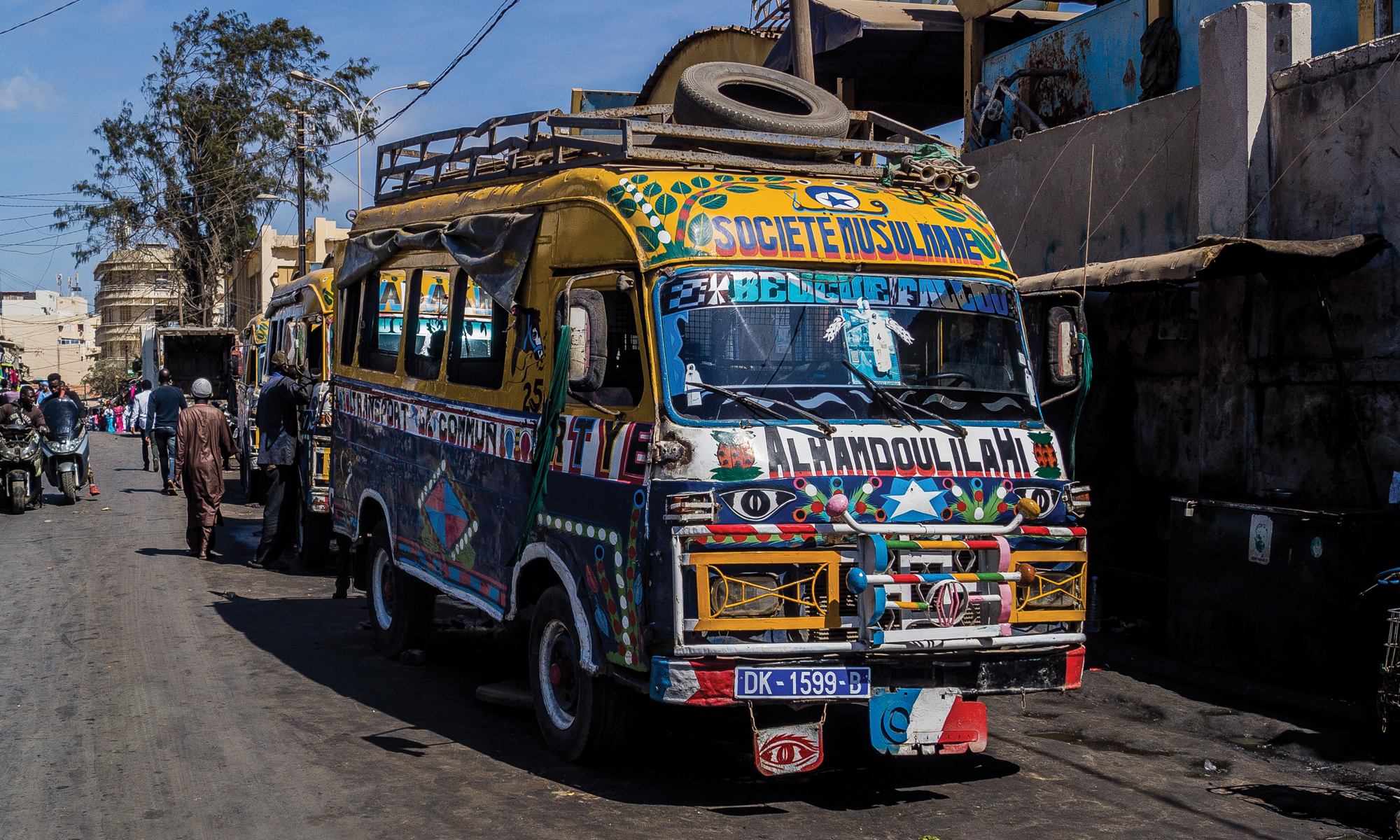
A car rapide in Dakar. (Photography by Allan Lake, Class of 2019)
During winter quarter, the College offered a Study Abroad program in Dakar, Senegal—the westernmost city in West Africa—for the first time.
“What surprised you the most about Senegal?” François Richard wants to know.
It’s the seventh week of winter quarter. Richard, an associate professor of anthropology, is meeting most of the students in the Dakar: African Civilizations program for the first time. The program crams a yearlong civ sequence into a quarter, with a new professor every three weeks.
“The commitment to relaxation,” says third-year Jonathan Poilpre. On the weekend, his host family enjoys eating and sleeping. And that’s enough.
More answers: How sweet the food is. (In Senegal, some American candy bars and sodas are even sweeter than the originals.) How host families urge you to eat, and eat, and eat. “The intense exercise culture,” says third-year Jennifer Feng; at sunset, every piece of equipment on the exercise beach on the Corniche is being used.
Several students mention transportation: The chaotic traffic, the extreme calm in the face of near collisions. The use of landmarks to navigate, instead of maps and addresses.
“The prevalence of American media,” says fourth-year Christopher Walker (now AB’18). (One example: Black Panther had recently opened in Dakar, with alternating screenings of version originale and dubbed French.) “How people react when I say I’m from America,” says third-year Mary Blair. She had assumed everyone would understand that, as an African American, she was the descendant of slaves; then she met people who had no knowledge of the transatlantic slave trade.
Others talk about the Senegalese people: Their disarming warmth, their willingness to stop and help strangers. The open-door policy with neighbors. “I was surprised by how much I missed my host family,” says fourth-year Alan Yang (now AB’18), who just got back from a weekend trip. His “little brother,” a toddler, had hugged his legs as he was leaving. (Laughter, a chorus of “aww”s.)
Richard first traveled to Senegal in 1999. He returned to do research for eight months, then again for two years. Since 2006 he’s spent two or three months a year here, doing historical research on farmers in the rural Siin province. His book Reluctant Landscapes: Historical Anthropologies of Political Experience in Siin, Senegal is forthcoming from UChicago Press. “I keep being surprised by Senegal,” he says, especially by the rapid development in the capital city of Dakar. “Over the last five years, the newness has been exponential.”
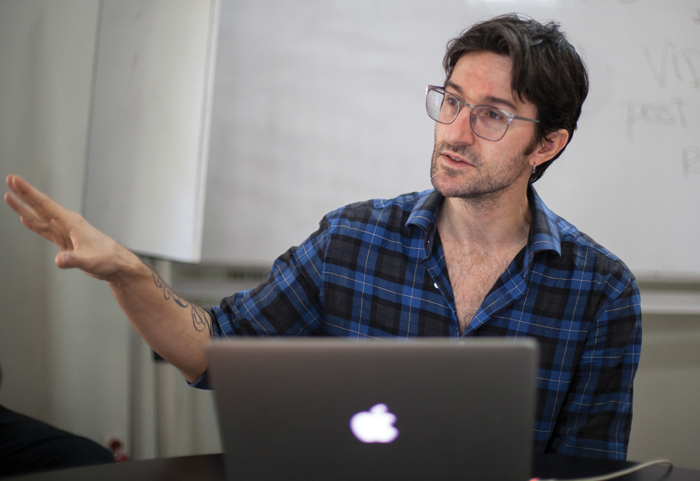
“My first time in Senegal, everything was surprising,” says Gregory Valdespino, AM’16, history graduate student and teaching assistant for the course. This is his second trip. As a person who struggles to remember names, he’s amazed by the “deep roster of names” that Senegalese people can retain. “It’s both surprising and intimidating.”
While the professors have changed throughout the quarter, Valdespino has remained a constant. He’s the one students text if they need help with something: finding a doctor, applying for a visa to the Gambia, dealing with roaches at their homestay.
Richard passes around the syllabus. His course, Dakar: Colonial and Postcolonial Africa, covers the period from the mid-19th century until just after 1960. The students have civ in the morning; in the afternoon they take French or Wolof, the most commonly spoken indigenous language and lingua franca of Senegal. All classes are held at the West African Research Center (WARC), a small pleasant complex with a courtyard and a café serving Senegalese food at student prices.
The syllabus lists two field trips: a visit to the Musée Théodore Monod d’Art africain and a weekend excursion to the former colonial capital, Saint-Louis. (Mary Blair, whose hometown is St. Louis, Missouri, eventually started telling people she was from Chicago, because the real answer caused so much confusion.)
Introductions made, syllabus reviewed, Richard turns to the topic of the day, Edward W. Said’s Orientalism (Pantheon Books, 1978). The book’s central argument: it is impossible to “acquire knowledge in a non-innocent way,” Richard says. “The lens distorts.”
When Napoleon invaded Egypt in 1798, “the first important colonial invasion,” as Richard describes it, he brought scientists and historians as well as soldiers. Said was the first to suggest that their allegedly objective research was shaped by colonial assumptions. The argument may sound familiar now, but it was extremely provocative in the late 1970s: “A large section of academia didn’t want to hear it.”
“And still don’t,” adds Valdespino.
The discussion circles around the “civilizing mission” of colonialism, the idea that colonial powers “were elevating societies that were inferior, yet perfectable,” Richard says.
As the assigned readings for the course explain, the colonial period in Africa was surprisingly brief. In 1884–85, the European colonial powers sat around a table in Berlin, carving out territories on a map like adolescent boys playing Risk. The results are absurd in places. The long thin country of the Gambia, claimed by the British—just 15 to 30 miles wide, running along either side of the Gambia River—was sliced out of French-controlled Senegal.
By 1960 Senegal, as well as many other African countries, had won independence. But the continent had been permanently transformed, with new national boundaries, economic systems, languages, and cultural practices.
The discussion shifts abruptly to the present. “Voluntourism”—doing short-term, unskilled volunteer work in developing countries—“feels very colonial to me,” says second-year sociology major Adriana Gonzales. “People think they’re doing good, but they often do a lot of harm.”
Richard nods. “The entire development industry is founded on colonial premises,” he says. While some development efforts are useful, “the very idea that there’s a tiered hierarchy in the world, where the West swoops in, SWAT-style, to give assistance, is predicated on a colonial geography.”
Third-year Katrina Weinert was struck by Said’s argument that “the ability to produce knowledge is in itself a form a power,” she says. “I think that’s something we can even struggle with today, being here, studying Africa. That power dynamic is still something that we should be wrestling with.”
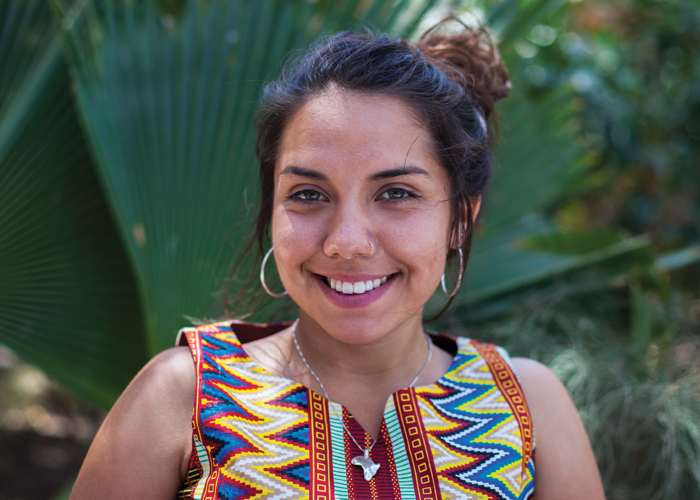
I love my host family,” says Adriana. “I am so ... When I think about the fact that we only have three weeks, I get so sad.”
The students—wearing T-shirts, shorts, flip-flops, and other summer gear in February—sit on colorful plastic chairs in WARC’s courtyard. They’ve placed their lunch orders at the window of the small café; 10 minutes or so later, the freshly cooked food is brought out.
It took Adriana a while to figure out who everyone in her host family was. “The matriarch of the house is Maam, which is grandparent in Wolof,” she says. Maam’s husband died years ago; her three adult children and their families all live in the house. “The oldest son, Birran, sleeps upstairs on the second floor with his second wife, whose name is Kiné.”
One of the café workers brings Adriana an intensely purple beverage. It’s bissap, the national drink of Senegal, brewed from hibiscus flowers.
“He spends two days with the first wife”—who lives somewhere in Dakar, she’s not sure where—“and two days with the second wife. What’s expected of a husband with multiple wives is that he splits his time evenly,” she says. “So I live on the second floor with Papa Birran and Mama Kiné.” Part of the second floor is rented to a Mauritanian family.
Maam lives on the first floor, along with her two younger children, Mama Adja and Tonton (Uncle) Amadou, and a gaggle of grandchildren. Fourth-year Hannah Walter (now AB’18) lives there too. Students were placed in host families in pairs, with one exception: third-year Naomi Weiner. (Having spent seven years in Brussels and a summer in Rwanda, she wasn’t too fazed.)
Adriana has built a particularly close relationship with Mama Adja and her daughter Mariama, who’s Adriana’s age. “Mama Kiné works a lot”—she’s the front desk manager at a luxury hotel downtown—“so I’ve spent a lot more time with Mama Adja.”
The entire family eats dinner together: “You can imagine it gets crowded.” A mat is spread on the ground in the courtyard, and a shared bowl of food set on it. Adults sit on low stools; if there aren’t enough, the younger children sit on the ground.
Before coming to Senegal, Adriana took an online Wolof course through Indiana University. She spoke French with her host family at first—she’s fluent in French, Italian, and Spanish and knows some Swahili—but switched to Wolof as her vocabulary grew.
A running joke is that the family will find her a Senegalese husband, but first she needs to learn how to cook.
“When it clicks, it clicks,” says Mariane Yade, programs and public relations officer at WARC, who arranges the host families. She put the UChicago students together in two nearby neighborhoods, Mermoz and Sacré-Coeur 3, so they could visit each other easily.
Yade often acts as a cultural translator. American students must have their own room, she informs prospective families. If there are two students, they need separate beds, which some families are surprised to hear. “No, no, no,” she says, “American students don’t share.”
The country is more than 95 percent Muslim. And while Senegalese people are famous for their tolerance (one widely cited example: Senegal’s first president, Léopold Sédar Senghor, was Catholic), students are expected to be respectful. “Don’t come home drunk or bring alcohol in,” says Yade. “Don’t go out too many times too late when they have to worry if you are safe.”
The handbook for the Senegal program, more than 50 pages long, includes a section prepared by WARC, spelling out other potential missteps. If you’re dating someone, for example, “love should not be demonstrated in front of your family members.” When the group first arrived, Valdespino held an additional closed-door orientation session, advising the students to clean up their social media if there was anything they didn’t want host families to see.
The African Civ program has no language requirement. Yade’s advice for students who don’t speak much French or Wolof: “Be very creative,” she says. “Become a mime or something.”
Without much of either language, Adriana’s housemate Hannah still found ways to connect. One night she cooked dinner: pasta Alfredo with mushrooms and spinach. The family had never eaten spinach; she bought it at a French supermarket. “They were joking that Grandma ate more of my meal than she usually does,” Hannah says. “Papa Birran was like, you have to cook tomorrow so we fatten her up.”
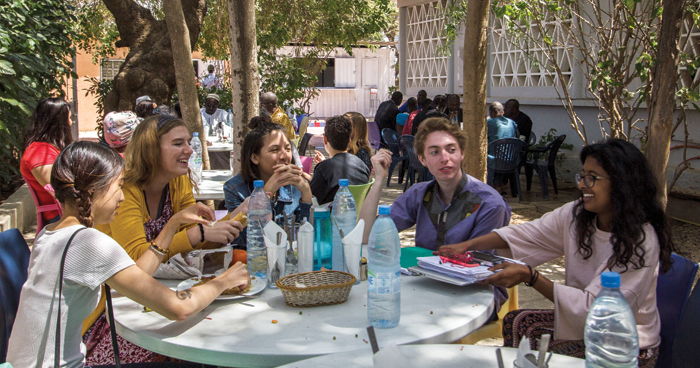
One of the articles assigned for day three of Richard’s class, “‘Circle of Iron’: African Colonial Employees and the Interpretation of Colonial Rule in French West Africa,” was written by Emily Lynn Osborn, associate professor of history and director of the Dakar program. It’s one of the most frequently cited articles from the Journal of African History, Richard says offhandedly. The students look suitably impressed.
Osborn’s books are Our New Husbands Are Here: Households, Gender, and Politics in a West African State from the Slave Trade to Colonial Rule (Ohio University Press, 2011) and Intermediaries, Interpreters, and Clerks: African Employees in the Making of Colonial Africa (University of Wisconsin Press, 2006). She won the Quantrell Award for Excellence in Undergraduate Teaching in 2016.
When her three-week teaching stint was over, Osborn remained in Senegal to oversee the program and work on her current book project, which focuses on aluminum casting. After World War II, the technique of aluminum casting—melting down scrap aluminum to make pots, spoons, even bicycle and car parts—spread through West Africa. Osborn is interested not only in the informal economy but also the migration of peoples and ideas.
She first visited Africa at age 7; her brother was in the Peace Corps in Sierra Leone. “That trip definitely made an imprint upon me,” Osborn says—so much so that she’s brought her own three children to Africa at around the same age. In high school she did an exchange program in Côte d’Ivoire; in college she studied for a year at Université Cheikh Anta Diop de Dakar.
It was Osborn who developed the movie-like structure for the African Civ program: a look at contemporary Senegal (which she taught), a flashback to the precolonial era (taught by archaeology professor Ibrahima Thiaw of the Université Cheikh Anta Diop), then the dramatic conclusion, colonialism to independence (taught by Richard).
During her three-week block, she covered “everything from architecture to religion to politics,” she says. “I wanted to ground the students in their daily life in Senegal.” On the second day of class, the students, working in teams, had to pick a destination, figure out how to get there, and give a presentation the next day.
Osborn also assigned students to make a Senegalese family tree. Some discovered their host families had members in Spain, Germany, Alaska. Others encountered touchy topics: a prior marriage, a first wife. “But by and large, it endeared the families to the students and vice versa.”
Students come to the program from a mix of majors—economics, sociology, political science, art history—and their projects for Osborn’s class reflected that. A sampling: utilities and inequality, mental-health care, Senegalese singer Youssou N’Dour, illegal and unregulated fishing, career aspirations for the upper class, politics and graffiti art, textiles and fashion, baobab trees and gender in Senegalese literature.
Katrina Weinert, a third-year majoring in public policy and comparative race and ethnic studies, did her research on portraits of signares, women of mixed French and African ancestry during the 18th and 19th centuries.
“A lot of the academic literature romanticizes signares as these beautiful, powerful women,” says Katrina, while ignoring the domestic slaves who also appear in the portraits. She noticed that signares were often portrayed in elevated positions—on an upper balcony, on a raised platform—and bathed in light, while the slaves would be in shadow.
At the National Archives of Senegal in Dakar, she trawled through hundreds of handwritten census records. She found an 1844 record for the household of Anna Colas Pépin, featured in a portrait made just a few years later. Anna Colas Pépin lived in the house now known as the Maison des Esclaves (House of Slaves), a museum to the slave trade on nearby Gorée Island. Just like the signare portraits, the census records are strictly delineated: at the top are free people, listed with both first and last names; underneath are slaves, with first names only.
“The slave trade had been abolished, but slavery was still legal,” says Katrina. The document she found was both “this amazing record of people’s lives and a definitive reminder that slavery was still happening.” Osborn was so impressed, she advised Katrina to submit the paper to African Arts, a peer-reviewed academic journal.
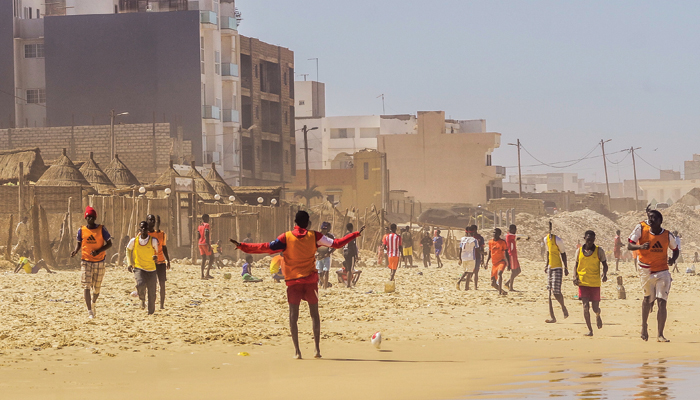
This Friday’s field trip is to the Théodore Monod museum, “a grand colonial structure with a fusty collection of traditional art,” as Artforum magazine has described it.
The museum was named for Monod, a French polymath, Richard tells the students. The bulk of its collection was gathered in the 1930s, during the Dakar-Djibouti mission, a famous expedition led by French ethnographer Marcel Griaule. “At every stop they collected and bought and stole various objects,” Richard says. “There’s a lot of shadiness around the acquisition.”
Richard and Valdespino mill around the small museum, chatting with the students as they examine masks, sculptures, drums. The objects are identified by ethnic group, a problematic concept that Richard has been exploring in class. Colonial states “crystallized ethnicity as a fact of identity,” he says, “in ways that are more rigid than how ethnicity was lived or understood prior to colonial intervention.”
The second floor of the museum holds a temporary exhibit of textiles. “Look at the way they’re exhibited,” Richard says. “Are artists identified individually?” (They are not.) “It’s a reflection of the colonial mind.”
The museum primarily caters to tourists and school groups; ordinary Senegalese people are not interested in it. For one thing, the labels are in French. It’s Senegal’s official language but spoken mostly by the educated elite. “There’s a complicity between ethnography and colonialism that doesn’t stop with independence,” Valdespino says. “How do museums decolonize? Can they?”
Richard tells a cluster of students about the Musée du quai Branly in Paris, a “hyper-flashy” museum of indigenous art. The objects there were chosen for their aesthetic appearance, rather than their significance for the people who created and used them. “Once they’re taken out of context, there’s only so much you can say,” he says. “Aesthetics is trumping information. Calling it ‘art’—there’s no concept of art for art’s sake in many African societies. What kind of violence is done by calling it art?”
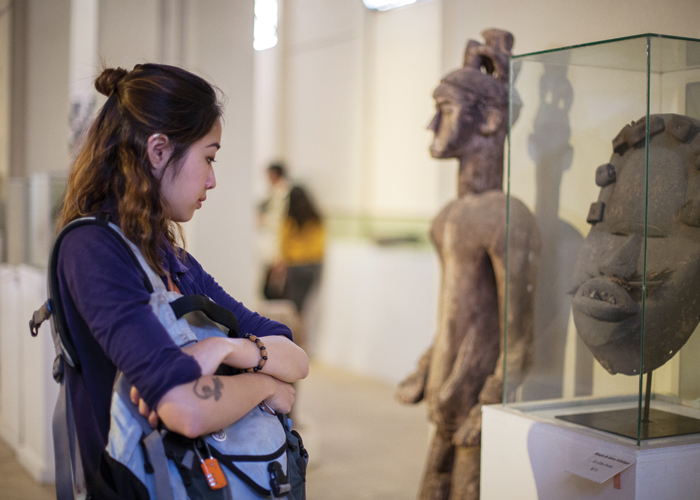
It’s a typical Saturday night in the Dabo household, where second-year Soulet Ali and third-year Angela Ma are staying. Their host parents are sitting in the living room in deep, comfortable leather chairs, watching Senegalese wrestling. “Oh, he’s my favorite!” Soulet says when wrestler Abdou Diouf comes on screen. Amy, their host mother, has cloth on her hands and feet; she’s just had henna patterns done and the dye isn’t set yet.
At first neither Soulet nor Angela could speak French or Wolof. And the Dabo parents don’t know English. When Angela arrived, she tried to ask host father Mamadou, a retired teacher, what he used to teach. He thought she was asking for another table in her bedroom. The sitcom-like confusion took a while to straighten out.
Luckily both of their college-age children, Adja and Papi, speak excellent English. (Neither one was home during the teaching/table incident.) Soulet helps Adja with her English homework, and in return Adja helps Soulet with her Wolof. “We’re very close,” says Soulet. “I’m fairly positive I’m going to know her for the rest of my life.”
Dinner this evening is spicy chicken on a bed of caramelized onions, with French fries added around the edge. The young people eat at a coffee table in the entryway, chatting in a mix of French, Wolof, and English. Adja points out that a Senegalese artist, Baaba Maal, sings on the Black Panther soundtrack. Soulet says it’s one of the best superhero movies she’s ever seen.
The older members of the family—including oldest daughter Beebap, who arrives with her husband and their four-month-old daughter—eat in the living room, in front of the TV. When everyone is finished, the food is gathered up and taken away, then a tray of juice drinks is brought out.
Papi carries a portable gas canister into the entryway and boils water for attaya, strong, sweet Senegalese tea. Adja and Soulet tease him about how sweet he makes it: “It’s not attaya avec sucre,” Soulet says, attaya with sugar. “It’s sucre avec attaya.” He pours the boiling tea back and forth, from one tiny glass to the other, until it foams. It’s dangerous. And delicious.
Angela, Soulet, and Adja have plans to go to a dance party, ElectrAfrique. Angela looks exhausted; at one point, she rests her head on Soulet’s shoulder. But she doesn’t want to stay in. It’s their last weekend in Dakar; there are trips planned for the other weekends. She wants to make the most of it.

Back in Chicago near the end of spring quarter, Mary is still processing her Senegal experience. “A lot of black Americans imagine Africa as this homeland, where you’ll be welcomed with open arms,” she says. “I don’t think I was necessarily disillusioned. But I had to challenge myself to understand what the experience of blackness is globally.”
In Saint-Louis, for example, the owner of a shop invited her to have tea. There had been a number of required readings about métis—people of mixed race—in Saint-Louis. So Mary asked, “Are you métis?” His response: “Yeah, like you.” She breaks into laughter at the memory. “In America I’m definitely considered on the darker end of the spectrum.” In Senegal, she was not.
“I do think I came back to the States a different person,” she says. “It’s hard to explain. I’m more comfortable as I navigate the world, more confident in my voice intellectually.”
For Adriana, the experience made her change her major: she dropped sociology for a double major in anthropology and comparative race and ethnic studies. She realized she prefers an ethnographic approach to research: “I love that human aspect of talking to people.”
She uses WhatsApp to chat with Mama Adja two or three times a week, mostly in Wolof. She has had to break the Senegalese habit of eating with her hands.
When asked, “How was Senegal?” or “How was study abroad?” Adriana doesn’t have much of an answer. “It was great! I loved it!” is her typical nonresponse. It’s a trip she’s been dreaming of—and preparing for—since high school, when she started taking French so she could travel to West Africa someday. “It’s difficult to be more specific,” she says. “I can’t express how much it meant to me.”
A history of African Civ
Winter quarter was the first time African Civilizations was taught in Senegal, but not in Africa. From 1999 to 2012, the College offered a program in Cape Town, South Africa, run by anthropologists Jean and John Comaroff. The program ended when the Comaroffs left for Harvard.
Since then, African Civ has been taught at the University’s Center in Paris. That program will continue, offered in alternate years to the Dakar program. Jennifer Cole, professor of comparative human development, who teaches African Civ in Paris and does research in Madagascar, explains: “Africa is not just a place. It’s a set of mobile ideas, people, and interactions.
“Treating Africa as an isolate geographical location goes back to an idea of ‘peoples and cultures’ mapped onto places, like colors on the map, but it’s never been so simple,” she says. “Teaching African Civ in Paris offers a way to take one particularly rich example, African-French relations, which are historically deep and complex, and explore them in depth.”
The College also offers a program in North Africa; a sequence of Middle Eastern Civilizations is taught in Rabat, Morocco. As in Dakar, the students in Rabat are housed with host families.
